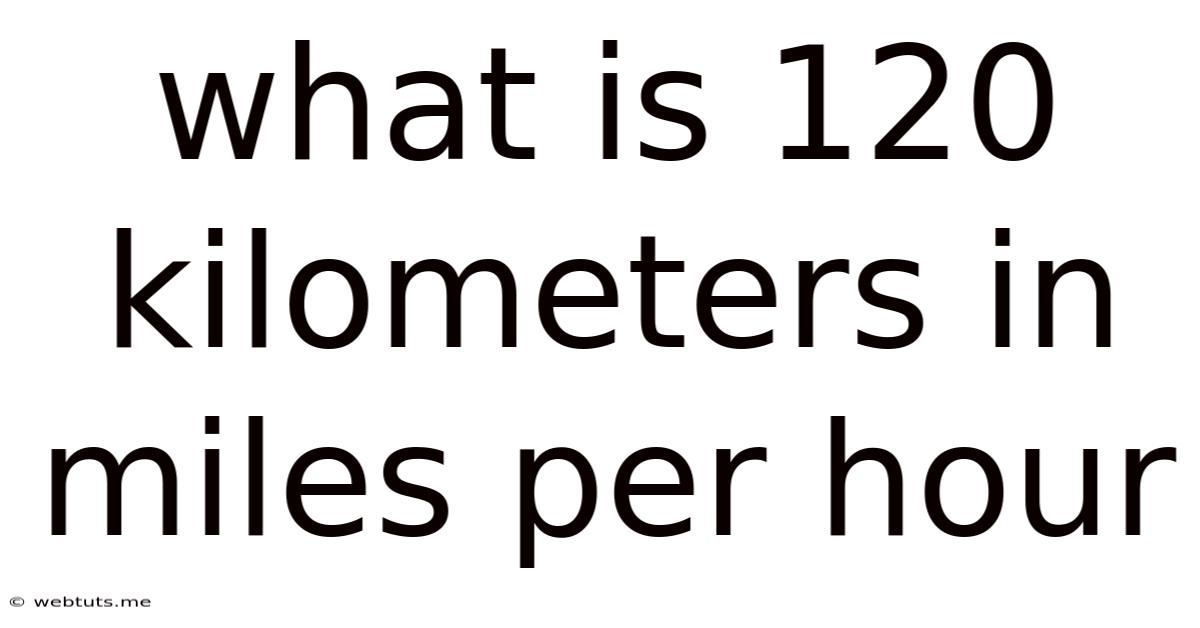What Is 120 Kilometers In Miles Per Hour
Webtuts
May 10, 2025 · 4 min read

Table of Contents
Decoding the Question: What is 120 Kilometers in Miles Per Hour?
The question "What is 120 kilometers in miles per hour?" is a bit of a trick! It's mixing up units of distance (kilometers) and speed (miles per hour). Kilometers measure distance, while miles per hour (mph) measures speed – the rate at which distance is covered over time. You can't directly convert kilometers to miles per hour because they represent different physical quantities.
To understand this better, let's delve into the concepts of distance, speed, and their units:
Understanding Distance and Speed
-
Distance: This is the amount of space between two points. It's measured in units like kilometers (km), miles (mi), meters (m), feet (ft), etc. 120 kilometers is a specific distance.
-
Speed: This is how fast something is moving. It's the rate at which distance is covered over a period of time. Speed is calculated by dividing the distance traveled by the time it took to travel that distance. Miles per hour (mph) or kilometers per hour (km/h) are common units of speed. Saying "120 kilometers" doesn't tell us the speed; it only tells us the distance.
To determine a speed, you need both distance and time. For example:
- If a car travels 120 kilometers in 2 hours, its speed is 60 kilometers per hour (120 km / 2 hours = 60 km/h).
- If the same car travels 120 kilometers in 1 hour, its speed is 120 kilometers per hour (120 km / 1 hour = 120 km/h).
- If a different car travels 120 kilometers in 3 hours, its speed is 40 kilometers per hour (120 km / 3 hours = 40 km/h).
Converting Units: Kilometers to Miles and Vice Versa
While you can't directly convert kilometers to miles per hour, you can convert kilometers to miles, which is a unit of distance. The conversion factor is approximately:
- 1 kilometer ≈ 0.621371 miles
Therefore, 120 kilometers is approximately:
120 km * 0.621371 mi/km ≈ 74.56 miles
Converting Kilometers Per Hour to Miles Per Hour
If the question were "What is 120 kilometers per hour in miles per hour?", then the conversion is straightforward:
120 km/h * 0.621371 mi/km ≈ 74.56 mph
This means that a speed of 120 kilometers per hour is approximately equivalent to 74.56 miles per hour.
Practical Applications and Examples
Understanding the difference between distance and speed is crucial in various real-world scenarios:
-
Driving: Speed limits are usually expressed in miles per hour (mph) or kilometers per hour (km/h). Knowing the conversion allows you to understand speed limits regardless of the units used. For instance, a 120 km/h speed limit is roughly a 75 mph speed limit.
-
Travel Planning: When planning a road trip, you need to know the distance (e.g., 120 kilometers) and your average speed to estimate the travel time.
-
Aviation: Aircraft speeds are often measured in knots (nautical miles per hour), which also requires unit conversions for accurate navigation and flight planning.
-
Sports: In many sports, speed is a critical factor. Converting units allows for accurate comparison of speeds across different systems of measurement.
-
Scientific Research: Accurate unit conversions are vital in scientific experiments and data analysis, especially when combining data from different sources using various units.
Beyond Simple Conversions: Factors Affecting Speed and Time
The simple conversions above only scratch the surface. Real-world travel times and speeds are rarely constant. Many factors can influence actual travel time:
-
Terrain: Driving uphill will significantly reduce your speed compared to driving on a flat surface. Similarly, mountainous terrain will dramatically increase travel time compared to driving on flat plains.
-
Traffic Conditions: Heavy traffic significantly reduces average speed, leading to longer travel times.
-
Weather Conditions: Rain, snow, or fog can drastically reduce safe driving speeds and increase travel times.
-
Vehicle Condition: The condition of your vehicle (e.g., engine performance, tire condition) will impact your speed and fuel efficiency.
-
Road Conditions: The quality of the road surface (e.g., potholes, construction zones) affects driving speed and safety.
Advanced Calculations: Accounting for Real-World Factors
To accurately estimate travel time, you'd need to incorporate these factors into your calculations. This often involves more complex mathematical models and may require using specialized software or tools. For example, GPS navigation systems use sophisticated algorithms to estimate travel time based on real-time traffic data, road conditions, and historical speed data for a given route.
Conclusion: The Importance of Clarity in Units
The initial question highlights the importance of precise language when discussing measurements. Confusing distance (kilometers) with speed (miles per hour) leads to an unanswerable question. Always clarify the units involved and ensure consistent use of units throughout calculations to avoid errors and misinterpretations. Understanding the relationships between distance, speed, and time, and the methods for converting units, is essential in various fields and daily life. By considering real-world factors, you can make more accurate estimations of travel time and effectively plan journeys.
Latest Posts
Latest Posts
-
How Many Cm Is 14 5 Inches
May 10, 2025
-
How Long Is 200 Cm In Inches
May 10, 2025
-
Cuanto Es 51 Kilos En Libras
May 10, 2025
-
How Far Is 5000m In Miles
May 10, 2025
-
How Many Day Till December 3
May 10, 2025
Related Post
Thank you for visiting our website which covers about What Is 120 Kilometers In Miles Per Hour . We hope the information provided has been useful to you. Feel free to contact us if you have any questions or need further assistance. See you next time and don't miss to bookmark.